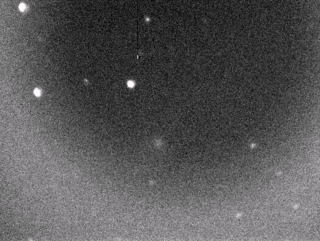I made the loop above from a number of CCD frames that I took on the night of the collision. The telescope used was the 14 inch S/C at the Pima College East Campus Observatory, Tucson, Az. The comet is the "star like" object that is moving downward toward the left of the frame. If you look closely, just before it repeats, you can just see a slight bright dot appear at the top of the comet. That was the impact!
Here is a NASA description of what was to happen during the collision:
A NASA spacecraft named Deep Impact is going to shoot an 820-pound projectile into the rocky, icy nucleus of Comet Tempel 1. The 23,000 mph collision will form a big crater, and Deep impact will observe the stages of its development, how deep it gets and how wide it becomes. Researchers expect a plume of gas and dust to spray out of the crater. Deep Impact will measure its composition and record what the billowing plume does to the comet's atmosphere. In all, Deep Impact should be able to peer into the new crater for almost 15 minutes before the craft speeds away, continuing, like its cometary quarry, to orbit forever around the Sun.
This blog will contain short video clips or images of different aspects of nature. There is no rhyme or reason why I post what I do...it is something interesting to me and maybe to you. Enjoy!........................... (All videos and images are copyright by David G. Iadevaia, Ph.D. Tucson, AZ)
Tuesday, December 28, 2010
Monday, December 27, 2010
Song of India?
In October of 1995 I traveled to India to view a total solar eclipse. I was excited about being in India. As a child I remembered watching a TV program about an Indian boy and his elephant. He would sing a song to his elephant. I remembered that song and when I got to India I hummed it for my Indian guide. He said he never heard the song and that it was a Hollywood invention. At that moment I decided that if it wasn’t an Indian song it would be before I left. At a village called Gato I assembled several children who were about to witness the eclipse and taught them the song!
Sunday, December 19, 2010
A total lunar eclipse
I flew the night of a total lunar eclipse to show the relative positions of the Sun and Moon as the eclipse began. I was much younger during my flying years...the flight originated from LaCholla Airpark where I kept my plane. Date of the eclipse was 26 September 1996. The video clip is from my Elements of Astronomy cdrom available for purchase at:
http://www.lulu.com/product/cd/elements-of-astronomy/4932003?productTrackingContext=search_results/search_shelf/center/1
http://www.lulu.com/product/cd/elements-of-astronomy/4932003?productTrackingContext=search_results/search_shelf/center/1
Monday, November 22, 2010
Effects of Natural Forces in Sabino Canyon
Prof. Iadevaia shows the effects of natural forces on Sabino Canyon in Tucson, AZ
Wind and Waves
A short video clip by Prof. Iadevaia showing local wind effects on the surface of the ocean producing small breaking waves on swells.
Optical Properties Of Ocean Water
Prof Iadevaia tests optical properties of ocean water for his Walden University students.
Three Color Absorption Test
Testing for absorption of the visual spectrum in ocean water by Prof. Iadevaia for his Walden University students.
Why using "rays" could lead to a misconception.
The use of "rays" is not a good idea because it can lead to a misconception as to how energy is radiated from a point source. This video clip is for my Walden University students.
A Typical Weatherstation Instrument Package
This video for Prof Iadevaia's Walden University students, shows the components of a typical weather-station instrument package . The instruments must be calibrated and housed in a standard way so that many of the instrument packages can be used at multiple locations providing weather data over vast areas. Calibration and procedures as to location, operation and placement of the instruments must be identical for the data to be reliable.
Absorption and Transmission of Light in a Liquid
Here is a demo for my Walden University students of the absorption and transmission of light in a liquid.
Subscribe to:
Posts (Atom)
